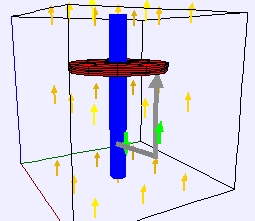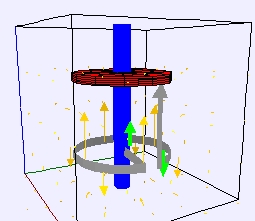Faraday
Disk Dynamo model (a) in external magnetic field and (b) attached to a
coil. Green arrow shows generated current and yellow vectors show
magnetic field.
Faraday Disk Dynamo Model
The EJS Faraday Disk Dynamo
shows a
conducting disk that rotates in a magnetic field. This produces a
current (homopolar
generator) and for certain
configurations, it is a self-exciting dynamo. A
self-exciting dynamo is the mechanical analog of a proposed mechanism
to produce the earth and sun's magnetic fields.
Ejs
must be installed to explore and change the model.
Exercises:
- "Ext B"
and "Constant ω":
Run the simulation
first with a uniform external magnetic field (yellow-orange field
vectors) "Ext B" and constant angular velocity
"constant ω".
The
green arrows show the direction of the current as the disk
rotates and the plot shows the current (green)
and angular
velocity (red) as
a function of time. Explain the reason for the current flow (and the
associated direction).
- Optional calculation:
This is a clearly a way to generate electricity, but it can require a
fairly large dynamo. Input different values for the constant
angular velocity, ω. Notice the associated values of
the current
produced. Show that the induced emf on a rotating disk in a
uniform field is Br2ω/2
where B is the external magnetic field, r
the radius of the disk and ω, the angular velocity.
If the magnetic
field is 1 T (fairly large), the resistance of the circuit carrying the
current is 1 Ω
and the plot shows the current in units of Amps and
angular velocity in units of radians per second, what is the radius of
the dynamo disk?
- "Ext B"
and "Constant
torque": This time, instead
of a constant angular velocity, assume a constant applied torque,
τ (start with τ=1).
Without an external magnetic field (and generated current), you would
expect the angular velocity to increase (or decrease) steadily. Why? In
this case, however, since the system settles down to a constant angular
velocity, there must be another torque acting on the system. Show that
the additional torque is due to the force (F
= iLxB)
due to a current
flowing in a magnetic field and is equal to i ∫ B r dr
where r is measured radially on the disk.
- "Coil"
and "Constant ω":
Neither of the previous
situations are self-exciting dynamos. In a self-exciting dynamo, the
current produced induces a magnetic force which changes causing a
changing current thereby setting up a feedback loop that keeps
the
current going without an external magnetic field (once there is an
initial non-zero current/magnetic field). Choose "Coil" and
"constant ω" to see the geometry of a system that
has the
potential to be a
self-exciting dynamo. Try values of ω greater than 1
and
less than
1. For values greater than 1, it seems like this might be a
way to generate lots of current with no work.
What is the catch? (Hint: Look at the value of the torque and
consider what is necessary to
keep ω
constant at larger and larger currents.)
- "Coil"
and "Constant
torque": Try some different
values of the initial ω when there is a
constant external
torque. When τ
= 1, can you find initial values of ω where the disk
changes
its direction of rotation and the magnetic field swaps direction? This
is a requirement for a model of the magnetic field of the earth or sun
(since
the magnetic field has changed over time). Repeat for another value of
the torque.
- "Capacitor"
and "Constant
torque": By adding in a
capacitor (and the additional non-linear differential equation), the
system can become chaotic. The plot now also shows the charge
as a
function of time (in blue). Try an initial value of
τ=1
and
ω= 3.0 and observe the phase space plot (plot of current,
charge
and angular velocity)-- this is similar to the Lorenz
attractor. What hallmarks of a
chaotic system does this system
exhibit?
References:
- Hecht, Physics:
Calculus, 2nd
edition, Brooks Cole, Chapter 20
(2000).
- Sir Edward Bullard, "The
stability of a homopolar dynamo," Mathematical
Proceedings
of the
Cambridge Philosophical Society,
51
(1955) 744-760.
- Raymond
Hide, Anne C. Skeldon and David J. Acheson, "A study of two novel
self-exciting single-disk homopolar dynamos: Theory" Proceedings fo the Royal
Society A, 452
(1996) 1369-1395.
- Irene
Moroz, "The Hide, Skeldon, Acheson dynamo revisited," Proceedings of the Royal
Society A, 463 (2007) 113-130.
Credits:
The Faraday Disk Dynamo Model
and
Exercises were created by Anne J Cox
using the Easy Java Simulations (EJS) authoring and modeling
tool.
You can examine and modify a
compiled EJS model if you run the
program by double clicking on the model's jar file.
Right-click
within the running program and select "Open EJS Model" from the pop-up
menu to copy the model's XML description into EJS. You must,
of
course, have EJS installed on your computer.
Information about EJS is
available at: <http://www.um.es/fem/Ejs/>
and in the OSP ComPADRE collection <http://www.compadre.org/OSP/>.



